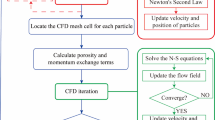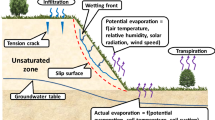Abstract
In this paper, the stress–strain responses of frozen sands and an elastoplastic constitutive model based on the homogenization theory of heterogeneous materials are presented. In the model, frozen soils are conceptualized as binary-medium materials consisting of bonded blocks and weak bands, and their mechanical behavior is described with elastic–brittle and elastoplastic constitutive models, respectively. By introducing two groups of parameters (i.e., the breakage ratio (λv and λs) and strain concentration coefficient (cv and cs) related to the spherical and deviatoric stress components), the proposed model incorporates the breakage process of ice crystals and nonuniform strain distributions between the matrix (bonded elements) and inclusions (frictional elements) of the heterogeneous frozen soil samples. Moreover, an elasticity-based model and a double hardening constitutive model are employed to simulate the mechanical properties of the bonded elements and the characteristics of the frictional elements, respectively. To provide appropriate and quantitative predictions with the binary-medium constitutive model proposed here, triaxial compression tests are performed on the frozen and unfrozen sands to determine the individual parameters at confining pressures of 300–1800 kPa. The model validations demonstrate that the predictions agree well with the available laboratory results.















Similar content being viewed by others
References
Zhou YW, Guo DX, Qiu GQ (2000) Geocryology in China. Science Press, Beijing
Lai YM, Xu XT, Dong YH (2013) Present situation and prospect of mechanical research on frozen soils in China. Cold Reg Sci Technol 87:6–18
Parameswaran VR (1985) Effect of alternating stress on the creep of frozen soils. Mech Mater 4:109–119
Parameswaran VR (1987) Extended failure time in the creep of frozen soils. Mech Mater 6:233–243
Tsytovich NA (1985) The mechanics of frozen ground (trans: Zhang CQ, Zhu YL). Science Press, Beijing
French HM (1996) The periglacial environment, 2nd edn. Essex, London
Zhu ZW, Kang GZ, Ma Y (2016) Temperature damage and constitutive model of frozen soil under dynamic loading. Mech Mater 102:108–116
Liu EL, Lai YM, Wong H, Feng JL (2018) An elasto-plastic model for saturated freezing soils based on thermo-poromechanics. Int J Plast 107:246–285
Zhao YH, Weng GJ (1996) Plasticity of a two-phase composite with partially debonded inclusions. Int J Plast 12:781–804
Zhao YH, Weng GJ (1997) Transversely isotropic moduli of two partially debonded composites. Int J Solids Struct 34:493–507
Zhu QZ, Shao JF, Mainguy M (2010) A micromechanics-based elasto-plastic damage model for granular materials at low confining pressure. Int J Plast 26:586–602
Zhou MM, Meschke G (2014) Strength homogenization of matrix-inclusion composites using the linear comparison composite approach. Int J Solids Struct 51:259–273
Nguyen L, Fatahi B (2016) Behaviour of clay treated with cement & fibre while capturing cementation degradation and fibre failure-C3F Model. Int J Plast 81:168–195
Dejaloud H, Jafarian Y (2017) A micromechanical-based constitutive model for fibrous fine-grained composite soils. Int J Plast 89:150–172
Zhou MM, Meschke G (2018) A multiscale homogenization model for strength predictions of fully and partially frozen soils. Acta Geotech 13:175–193
Lai YM, Jin L, Chang XX (2009) Yield criterion and elasto-plastic damage constitutive model for frozen sandy soil. Int J Plast 25:1177–1205
Lai YM, Yang YG, Chang XX (2010) Strength criterion and elasto-plastic constitutive model of frozen silt in generalized plastic mechanics. Int J Plast 26:1461–1484
Lai YM, Xu XT, Yu WB (2014) An experimental investigation of the mechanical behavior and a hyperplastic constitutive model of frozen loess. Int J Eng Sci 84:29–53
Ghoreishian A, Grimstad SA, Kadivar G (2016) Constitutive model for rate-independent behavior of saturated frozen soils. Can Geotech J 53:1646–1657
Lai YM, Liao MK, Hu K (2016) A constitutive model of frozen saline sandy soil based on energy dissipation theory. Int J Plast 78:84–113
Xu GF, Wu W, Qi JL (2016) Modeling the viscous behavior of frozen soil with hypoplasticity. Int J Numer Anal Meth Geomech 40:2061–2075
Zhou ZW, Ma W, Zhang SJ (2016) Multiaxial creep of frozen loess. Mech Mater 95:172–191
Loria AF, Frigo B, Chiaia B (2017) A non-linear constitutive model for describing the mechanical behaviour of frozen ground and permafrost. Cold Reg Sci Technol 133:63–69
Roscoe KH, Schofield AN, Thurairajah A (1963) Yielding of clays in states wetter than critical. Geotechnique 13:211–240
Lade PV, Duncan JM (1975) Elasto-plastic stress-strain theory for cohesionless soil. J Geotech Geoenviron Eng 101:1037–1053
Lade PV (1977) Elasto-plastic stress–strain theory for cohesionless soil with curved yield surfaces. Int J Solids Struct 13:1019–1035
Zheng YR, Kong L (2005) Generalized plastic mechanics and its application. Eng Sci 7:21–36
Yao YP, Sun DA, Matsuoka H (2008) A unified constitutive model for both clay and sand with hardening parameter independent on stress path. Comput Geotech 35:210–222
Yao YP, Hou W, Zhou AN (2009) UH model: three dimensional unified hardening model for overconsolidated clays. Geotechnique 59:451–469
Yao YP, Zhou AN (2013) Non-isothermal unified hardening model: a thermo-elasto-plastic model for clays. Geotechnique 63:1328–1345
Nguyen L, Fatahi B, Khabbaz H (2014) A constitutive model for cemented clays capturing cementation degradation. Int J Plast 56:1–18
Hashiguchi K (1980) Constitutive equations of elasto-plastic materials with elastic-plastic transition. J Appl Mech 47:266–272
Hashiguchi K, Ozaki S (2008) Constitutive equation for friction with transition from static to kinetic friction and recovery of static friction. Int J Plast 24:2102–2124
Nakai T, Hinokio M (2004) A simple elasto-plastic model for normally and over consolidated soils with unified material parameters. Soils Found 44:53–70
Liu MD, Carter JP (2002) A structured Cam-clay model. Can Geotech J 39:1313–1332
Desai CS (2015) Constitutive modeling of materials and contacts using the disturbed state concept: part 1–Background and analysis. Comput Struct 146:214–233
Desai CS (2015) Constitutive modeling of materials and contacts using the disturbed state concept: part 2–Validations at specimen and boundary value problem levels. Comput Struct 146:234–251
Liu MD, Carter JP, Desai CS (2003) Modeling compression behavior of structured geomaterials. Int J Geomech 3(2):191–204
Yin ZY, Chang CS, Hicher PY, Karstunen M (2009) Micromechanical analysis of kinematic hardening in natural clay. Int J Plast 25:1413–1435
Gao Z, Zhao J (2012) Constitutive modeling of artificially cemented sand by considering fabric anisotropy. Comput Geotech 41:57–69
Shen WQ, Shao JF (2016) An incremental micro-macro model for porous geomaterials with double porosity and inclusion. Int J Plast 83:37–54
Liu EL, Lai YM, Liao MK, Liu XY (2016) Fatigue and damage properties of frozen silty sand samples subjected to cyclic triaxial loading. Can Geotech J 53:1939–1951
Ma W, Wu ZW, Zhang LX (1999) Analyses of process on the strength decrease in frozen soils under high confining pressures. Cold Reg Sci Technol 29:1–7
Shen ZJ (2002) Breakage mechanics and double-medium model for geological materials. Hydro- Sci Eng 4:1–6 (in Chinese)
Shen ZJ, Hu ZQ (2003) Binary medium model for loess. J Hydraul Eng 7:1–6 (in Chinese)
Shen ZJ (2006) Progress in binary medium modeling of geological materials. In: Wu W, Yu HS (eds) Trends in geomechanics. Springer, Berlin, pp 77–99
Liu EL, Yu HS, Zhou C, Nie Q, Luo KT (2017) A binary-medium constitutive model for artificially structured soils based on the disturbed state concept and homogenization theory. Int J Geomech 17:04016154
Liu EL (2005) Binary medium model for structured soils. J Hydraul Eng 36:391–395
Liu EL, Zhang JH (2013) Binary medium model for rock sample. Constitutive modeling of geomaterials. Springer, Berlin, Heidelberg, pp 341–347
Liu EL, Luo KT, Zhang SY (2013) Binary medium model for structured soils with initial stress-induced anisotropy. Rock Soil Mech 34:3103–3109 (in Chinese)
Liu Z, Yu X (2011) Coupled thermo-hydro-mechanical model for porous materials under frost action: theory and implementation. Acta Geotech 6(2):51–65
Xu XT, Wang YB, Yin ZH, Zhang HW (2017) Effect of temperature and strain rate on mechanical characteristics and constitutive model of frozen Helin loess. Cold Reg Sci Technol 136:44–51
Xu XT, Li QL, Xu GF (2019) Investigation on the behavior of frozen silty clay subjected to monotonic and cyclic triaxial loading. Acta Geotech. https://doi.org/10.1007/s11440-019-00826-6
Chang D, Lai YM, Yu F (2019) An elastoplastic constitutive model for frozen saline coarse sandy soil undergoing particle breakage. Acta Geotech. https://doi.org/10.1007/s11440-019-00775-0
Xu GF, Wu W, Qi JL (2016) An extended hypoplastic constitutive model for frozen sand. Soils Found 56(4):704–711
Cai C, Ma W, Zhou Z et al (2019) Laboratory investigation on strengthening behavior of frozen China standard sand. Acta Geotech 14:179–192
Wang JG, Leung CF, Ichikawa Y (2002) A simplified homogenization method for composite soils. Comput Geotech 29:477–500
Shen ZJ (1995) A double hardening model for clays. Rock Soil Mech 16:1–8 (in Chinese)
Liu EL, Xing HL (2009) A double hardening thermos-mechanical constitutive model for overconsolidated clays. Acta Geotech 4:1–6
Liu EL (2010) Breakage and deformation mechanisms of crushable granular materials. Comput Geotech 37:723–730
Lemaitre J, Chaboche JL (1970) Mechanics of solid materials. Cambridge University Press, London
Lu DC, Du XL, Wang G, Zhou A et al (2016) A three-dimensional elastoplastic constitutive model for concrete. Comput Struct 163:41–55
Acknowledgements
The authors appreciate the editor and reviewers very much for their comments in revising the paper. This research was supported by National Natural Science Foundation of China (41771066), the 100-Talent Program of the Chinese Academy of Sciences (Granted to Dr. Enlong Liu), and Key Research Program of Frontier Sciences of Chinese Academy of Sciences (QYZDY-SSW-DQC015).
Author information
Authors and Affiliations
Corresponding author
Additional information
Publisher's Note
Springer Nature remains neutral with regard to jurisdictional claims in published maps and institutional affiliations.
Rights and permissions
About this article
Cite this article
Zhang, D., Liu, E. & Huang, J. Elastoplastic constitutive model for frozen sands based on framework of homogenization theory. Acta Geotech. 15, 1831–1845 (2020). https://doi.org/10.1007/s11440-019-00897-5
Received:
Accepted:
Published:
Issue Date:
DOI: https://doi.org/10.1007/s11440-019-00897-5




